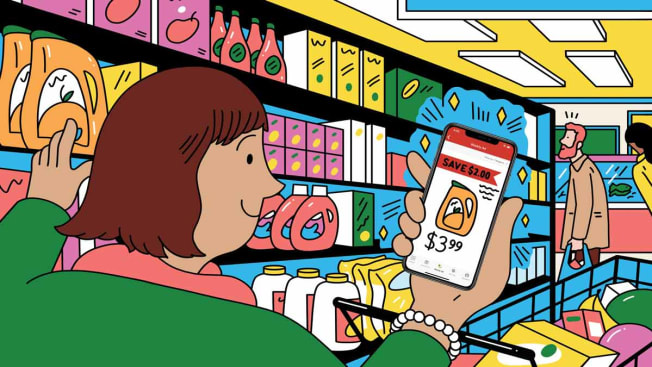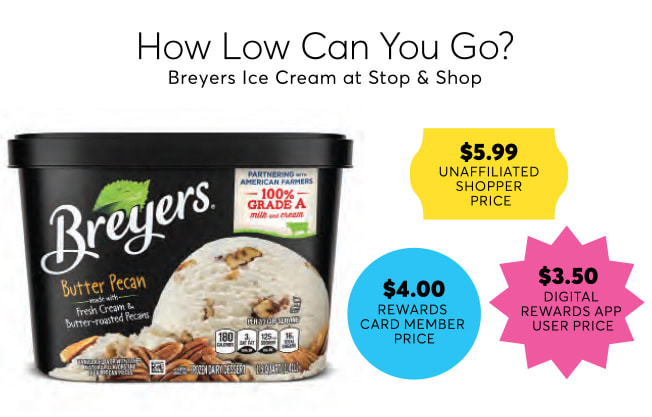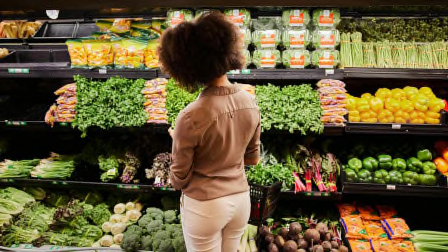How to Save Big With Digital Coupons
Paper discounts have given way to digital ones and online loyalty programs. Here's how to cut your costs right now.

When it comes to ice cream, I am faithfully unfaithful to any single brand, especially if the price is right. Häagen-Dazs—yes. Ben & Jerry’s—sure. Blue Bunny—bring it on. On the belief that no one should break their diet and the bank at the same time, when guilty pleasures are on special, I indulge.
So the moment I spotted the Stop & Shop circular featuring any variety of Breyers ice cream at two for $8, it was a done deal. Because the 48-ounce container is usually $5.99, I was staring down savings of $1.99 each! The deal was further sweetened by a digital coupon that I, as a Stop & Shop Go Rewards member, could download right to my phone. Ninety-six ounces of ice cream for $7! Score!
Saving a few dollars here and there on ice cream or other groceries might not quicken everyone’s pulse. Even I will admit that managing piles of paper scraps or spending precious minutes uploading coupons before shopping might strike some as more effort than it’s worth. But last year, just before Thanksgiving, my Stop & Shop receipt showed that I’d saved $581.63 so far in 2022—all before even buying one can of cranberry sauce. And that’s just at one store, though we shop at several. Not bad for a family of two.

Join the Club
When Coca-Cola created what may have been among the first paper coupons—handwritten slips “entitling the bearer” to a free glass of Coke in 1888—the company probably didn’t know that its marketing ingenuity would revolutionize how other companies drive business.
For nearly a century after the introduction of S&H Green Stamps in 1896, they reigned supreme for many people. Though not coupons per se, shoppers could expect to be rewarded with little green stamps for patronizing shops in the S&H network, which they could then affix to collectors’ books and redeem for premiums from an S&H Redemption Center or catalog.
While the Green Stamp era has passed, the idea of rewarding consumer loyalty is still going strong, with many grocery chains offering some version of a loyalty program. Customers at Publix stores, for example, can join Club Publix, launched in 2020, and receive $5 off an in-store purchase of $20 or more. Members also get a peek at the weekly circular a day early and have access to digital coupons via the Publix mobile app.
Stop & Shop offers a two-tier loyalty program in its stores. Tier one is Stop & Shop Rewards, which offers weekly discounts online and at the register for items featured in the store’s circular. Tier two offers members the opportunity to earn rewards and save on purchases with digital coupons via the Stop & Shop Go Rewards mobile app or website. Per Jensen, Stop & Shop’s director of loyalty, says that the store can give bigger discounts with digital coupons because there are higher logistics costs when customers redeem paper versions.
A downside of digital deals is the contact information and data about your shopping behavior that you give up for a discount. This may especially matter to you if you’re already deluged by marketers, including scammy ones. (For advice on how to avoid them, see CR’s Security Planner.)
There are a couple of workarounds. A representative for Albertsons, one of the nation’s largest food and drug retailers, says that people who might not have access to smartphones and mobile coupons or who want to avoid oversharing can request those discounts at the register. Stop & Shop informed CR of a pilot program to install kiosks in select stores where customers will be able to scan their physical rewards card or enter their phone number to access a small printed guide of the best circular offers and digital deals, no smartphone needed.
Speaking as someone who has reversed course halfway to the grocery store after realizing that I’d left my phone at home, I am firmly in the digital camp. But my ultimate allegiance is to the deal. If clipping coupons can also help me save money, I say pass the scissors.
The New Way to Coupon
Couponing is a numbers game where time spent translates into savings earned. CR consulted with expert deal detectives to help you make the most of your time in the service of saving. Whether you have 30, 60, or 90 minutes a week to devote to couponing, these tips will help focus your efforts.
Start with the half-hour level suggestions, and if time permits, try incorporating techniques from the hourlong and 90-minute couponing tips.
30 Minutes
Join rewards and loyalty programs at your favorite stores. Albertsons, Safeway, and Vons share a loyalty program that features $5 welcome savings off a $25 in-store purchase at sign-up. Members earn a point for every dollar spent on groceries. Every 100 points earns a Reward. And 10 Rewards equals $15 off your entire grocery purchase. Pro tip: You can supercharge those savings while keeping your grocery budget in check by purchasing a store gift card that allows you to earn 2 points for every dollar spent on groceries.
Buy a Sunday newspaper to get the coupon inserts. Yes, it can still pay to go old-school. So search the inserts for coupons for products you regularly use that you wouldn’t substitute for cheaper or generic options. If you find a coupon for one of your must-have items, consider purchasing a second paper to double down on buy one, get one deals.
Use coupon “matchups.” Some retailers allow you to do coupon matchups, where you can save more by combining store-offered discounts with matching manufacturer coupons. For example, if the CVS circular features Bounty paper towels at two for $5, a manufacturer’s coupon for the same product would be a matchup. To find them, do an online search of a store where you shop and add the word “matchup.” Deal bloggers such as For The Mommas and The Krazy Coupon Lady create weekly store deal/coupon breakdowns. Most will help you find the coupons that match up to the products.
Give yourself coupon reminders. Try whatever method helps you remember to bring coupons when you shop. Use your phone’s voice memo option, set calendar alerts for dates when things you want go on sale, or just put sticky notes on your refrigerator.
Set a grocery budget and stick with it. Many people can’t resist a good deal and load their carts with extraneous items they don’t really need. Make sure the lure of a bargain doesn’t prompt you to spend more than you budget for your weekly or monthly grocery shopping. Shop from a list so that you buy only those things on it.
60 Minutes
Watch coupon update videos on YouTube. Searching terms like “deals this week” or “coupon with me” will yield videos created by super-couponers like Star Smith, who offers weekly 10- to 25-minute store-specific deal updates, with tips on how to maximize them with manufacturer coupons. National retailers like CVS, Target, and Walgreens are the subject of the largest number of videos, but you will also find updates for local and regional retailers.
Remember that receipts are currency. Use rebate apps like Fetch Rewards and Ibotta to take in-app pictures of your cash register receipts to earn points that you can convert to Visa gift cards. Fetch gives subscribers a minimum of 25 points for every receipt that they upload. Users receive bonus points by buying specific items from a rotating list of manufacturers. For example, Bayer recently offered 1,500 bonus points if you bought at least one bottle of Bayer Cardio 50-count-plus low-dose aspirin. For 11,500 points, app users can get a $10 Visa prepaid card. A $50 Visa card requires a 52,500-point cash-out.
Find a Facebook couponing group. Typing “couponing group” into the social media platform’s search bubble will have you scrolling through groups with as many as 1.5 million followers. You can narrow your search by using the city filter under the groups icon. Shoppers in your area may have tips on local retailers and news about nearby unadvertised spot sales. Note that the Coupon Information Corporation, an industry group, cautions that visitors to these groups should keep an eye out for counterfeit coupons as well as coupon “glittering” or “shimmering,” which is improperly using a coupon to purchase items not intended by the company or store that issued the coupon.
Subscribe to a coupon provider. Depending on where you live, that can be cheaper than buying a Sunday newspaper. Coupon clipping services, also called coupon fairies, like The Coupon Marketplace, post images of paper coupons you can buy. A coupon on the site for $2 off any one Nature’s Bounty Vitamin was on sale for 20 cents. The cheapest shipping option was USPS first-class mail for $1, which makes sense when you buy coupons in one or more bundles of 10. Pro tip: The coupon values in newspaper inserts can vary by region, even if they are offered by the same manufacturer. That 50-cent offer in Pennsylvania may be worth 75 cents in Texas. Coupon fairies in different regions have access to inserts you might not. The Sunday Coupon Inserts website offers a subscription service that will ship whole inserts from companies like Procter & Gamble or SmartSource. The December P&G insert featured $82 worth of coupons, from 50 cents off any Pepto-Bismol product to $10 off Olay Regenerist facial moisturizer. Be aware that the practice is controversial. The Coupon Information Center warns that the coupons could be counterfeit, and says that the practice of selling coupons can violate manufacturers’ policies and void the coupons.
90 Minutes
Join a manufacturer’s email list. Procter & Gamble has 65 brands across 10 product categories and will send you weekly coupons and free offers via its P&G Good Everyday rewards program that you can print at home. Kimberly-Clark, the producer of brands like Kleenex and Huggies, has email sign-up prompts on the websites of individual brands like Scott tissue that will deliver deal offers to your inbox. Beech-Nut will email coupon sets to those who request them. On the site, parents can receive discounts for up to five little ones. PepsiCo’s Tasty Rewards will mail members up to 10 coupons of their choice. The program offers a print-at-home option and will load digital coupons to the retailers Publix and Family Dollar for Frito-Lay and Pepsi products.
Contact the manufacturers of your favorite brands to ask for coupons. Many will oblige with high-value coupons, perhaps for staples you like or for new products to try. I went to the Chobani yogurt website, navigated to customer care, and clicked the connect button that produced a contact form with a message field. I wrote that Chobani is one of my favorite brands but lately I’ve been buying whatever is on sale. I fished by asking whether they could share any coupons. About a week later four coupons arrived, and two of them were for free yogurt!
Editor’s Note: This article also appeared in the February 2023 issue of Consumer Reports magazine.
It was updated on Jan. 13, 2023, to include additional information from the Coupon Information Corporation. It was originally published Jan. 5, 2023.




















